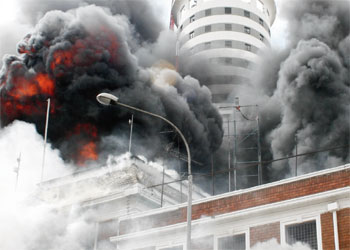By Milicent Muthoni
If you are reading this, then you are lucky to have been on the right side of the fire. Many of us have heard nasty stories of fire but have very little information on how to avoid or escape it.
This is evident in the way both staff and non-staff members panic when a fire breaks out. They scamper in fright, ignorant of the fact that there is, if any, a fire escape staircase. And it is seen through the throngs that crowd the scene of a fire, oblivious of the dangers they put themselves in and the inconvenience they present to fire fighters.
Donald Andolo, an architect with Sound Designs Ltd, is on a campaign to keep the fire burning. He says he will not let people ignore or forget the Nakumatt Downtown fire incident and many other fires that have been burning under the radar.
While most of us only know of the two recent fires, Andolo says there have been at least 23 fires reported in the media in January alone. And he would know, for he has been tracking and recording the fires.
He was jolted into action by an incident on December 24, last year, where a fire broke out at Lang’ata Road Kobil filling station destroying a truck, seven cars and property worth millions of shillings.
"I felt the need to do something about such incidents. Both life and property are too precious to be lost in avoidable fires," he says.
A search on the Internet for reliable information on fire or organisations that address fire safety and security yielded nothing. "There is very little information out there regarding fire in Kenya," laments Andolo.
Safety rating
Brian Chunguli, the chief fire officer at the Fire Station on Tom Mboya Street in Nairobi, concedes to the failure of the fire officers to sensitise people on fire safety. He, however, refuses to comment on the fire safety rating of any particular building, instead opting to enumerate the requirements for fire safety in buildings, as stipulated in the Fire Draft Policy, 2005: "We check buildings for fire notices, portable and fixed fire equipment, alternative exits and accessibility to the fire engine in case of a fire".
Buildings are supposed to be approved for fire safety at design stage, before occupation and annually after occupation. A developer should, therefore, receive a fire clearance certificate before occupying a building.
The Council runs annual audits on buildings at a fee but these have been criticised as being more of a revenue collection exercise for a cash-strapped Council than a way of ensuring public safety. Many developers allegedly pay the fees without necessarily having their buildings inspected.
When any building changes users, the fire safety systems should be updated and retrofitted appropriately. This is especially so for buildings like Woolmatt House that housed the ill-fated Nakumatt Downtown. It was old and had been gazetted for conservation. It, therefore, required some structural changes to accommodate a supermarket store.
Exits obstructed
Stay informed. Subscribe to our newsletter
Review of fire systems hardly happen as is evident in the numerous market stalls developing in the city, which risk the lives of occupants, many having inadequate extinguishers and no emergency exit routes. When they exist, gangways and escape routes are often obstructed with furniture, storage boxes and cleaners’ equipment, reducing the width of escape routes and making evacuation difficult. Even worse is the placing of electrical equipment such as portable heaters, computers and photocopiers on these exit points.
Changes of floor levels or tripping and slipping hazards such as taped electrical extension leads, unstuck flooring tiles and loose mats on the route can also obstruct fire escape.
Emergency doors are often locked for security during working hours thus endangering the lives of occupants should there be a fire or any other disaster. Fire exits should always lead to an open place where people are no longer in danger and from which they are able to move further away. Fire exit doors should open immediately and without the use of a key. It is recommended to use break-glass bolts, which are released by breaking a glass tube door or a panic lock that may be released by applying pressure on a bar running across the full width of the door.
All internal fire escape doors must be kept closed but not locked and they should open outwards. They should be automatic self-closing doors that keep flames, smoke and toxic gases from spreading into escape routes.
Properly labelled
Emergency escape routes should be properly signed/labelled as stipulated in the Fire Draft Policy. Pictograms of the running man, an open door and directional arrows may be supplemented with text. In addition, fire escape routes should be provided with external lighting preferably with emergency escape lighting since power is likely to go off. Other areas that must be lit include underground and windowless parts of the premises, core stairways, internal corridors more than 30 metres long and open plan office areas of more than 60 square metres.
A circular released by the Fire Department of the Nairobi City Council in 2007 compelled all buildings to present a fire safety plan. Every building must have a comprehensive emergency plan and a fire safety floor manager. A copy of the emergency plan should be kept in a second place other than the workplace, for instance, at the gatehouse. Such a plan should designate a smoking area provided with a fire extinguisher whose doors are kept shut. Other non-smoking areas should have working smoke sensors to detect smoke.
The building should be divided into compartments that are separated by fire resistant walls and doors. No offices should extend to more than 10,000 square feet unless separated from all other parts of the same building by fire-resistant division walls.
But when they must be fitted with ducting or building services, all spaces must be completely filled with fire-resistant stopping.
According to the building code, external walls of any building, other than a small house, should be non-combustible. It cannot be emphasised that separating walls between buildings should rise above the roof given that the recent fire at Nakumatt was kept from spreading to buildings on Kimathi Street by the party wall of the neighbouring Alibhai Shariff building.
Protection master plans
In storage buildings like warehouses, the external wall should have a fire resistance of four hours, while in any other commercial building it should have a fire resistance of two hours. For residential flats, the separating wall should have a fire resistance of one hour. The number and size of exits from the building should be sufficient for the use to which the building is put and the number of people in it.
There should be egress plans for assisting the disabled and for visitors and these should be rehearsed in regular fire drills. Staff members should be taught to evacuate non-staff members. Staff must be trained on how to call the fire brigade and use the fire extinguishers and the alarm system. They must also know the location and use of the escape routes and the assembly points. Furthermore, there must be ramps in place at all changes of level on escape routes for the disabled.
When considering fire safety, there is also the urban planning aspect whose scope goes beyond the individual building to the block, the neighbourhood and the city at large. Allan Mwaura, a lecturer at the Department of Urban Planning, says the council should ensure reticulation of fire hydrants around the city and that hydrants are operational and with water.
"Cities need to prepare and update their fire protection master plans," he says. "According to planning regulations stipulated in the Physical Planning handbook, there should be a fire station for every 50,000 to 100,000 people, depending on the likelihood of a fire incident. But in Nairobi, there’s only one operational station on Moi Avenue, while the other sub-stations at Industrial Area and Ruaraka are non-functional."
Separation of buildings
Separation of buildings from each other is provided for in the building code — the distance between a building and the boundary of the nearest adjacent plot should be more than twice its height, except in the case of a small house where such distance reduces to 10 feet.
"The city is well planned into streets and service lanes of appropriate width, but we still need to demarcate exclusive emergency lanes on our roads as well as parking space for fire engines, ambulances and police cars," notes Mwaura.
As was the case with the Nakumatt incident, barriers placed at the edge of the walkway outside a building inhibit movement. "Building owners would rather have bollards (fixed posts), which serve the purpose of demarcation without impeding flow of traffic," advises Mwaura.
Buildings should always have water exclusively used for fire fighting and for multi-storey buildings. There should be wet risers on external walls for the firemen to connect and pump water up.
According to the Factories and Other Places of Work Act, stores for combustible materials should be sited at secure flame-proof locations inside or outside the building and should have ‘No Smoking’ signs or other appropriate signs.
There should be regular inspection of electrical equipment that check conditions of cables and appliances, fuse ratings, wiring, socket loading and extension leads that may cause tripping. Areas where solvent-based adhesives are used should be well ventilated in order to prevent the build-up of flammable vapours.
Lists of fame and shame
Extinguishers should generally be located at exits, in corridors that form parts of escape routes, and on landings or near special risk areas. One extinguisher should serve a radius of 30 metres.
The fire detection and alarm system (FDA system) should be regularly monitored, as should fixed fire-fighting installations such as automatic sprinkler systems and halon flooding systems in computer suites.
Ceilings should be fitted with a door (scuttle) to allow access to the roof space while every chimney must extend above the adjoining roof.
Andolo intends to make the public more aware of the destructive potential of fire and affirm efforts in fire safety. "We need to have safety awards and make public lists of fame and shame, which indicate the safest buildings and those notorious for endangering their tenants," he says.
 The Standard Group Plc is a
multi-media organization with investments in media platforms spanning newspaper
print operations, television, radio broadcasting, digital and online services. The
Standard Group is recognized as a leading multi-media house in Kenya with a key
influence in matters of national and international interest.
The Standard Group Plc is a
multi-media organization with investments in media platforms spanning newspaper
print operations, television, radio broadcasting, digital and online services. The
Standard Group is recognized as a leading multi-media house in Kenya with a key
influence in matters of national and international interest.
 The Standard Group Plc is a
multi-media organization with investments in media platforms spanning newspaper
print operations, television, radio broadcasting, digital and online services. The
Standard Group is recognized as a leading multi-media house in Kenya with a key
influence in matters of national and international interest.
The Standard Group Plc is a
multi-media organization with investments in media platforms spanning newspaper
print operations, television, radio broadcasting, digital and online services. The
Standard Group is recognized as a leading multi-media house in Kenya with a key
influence in matters of national and international interest.









